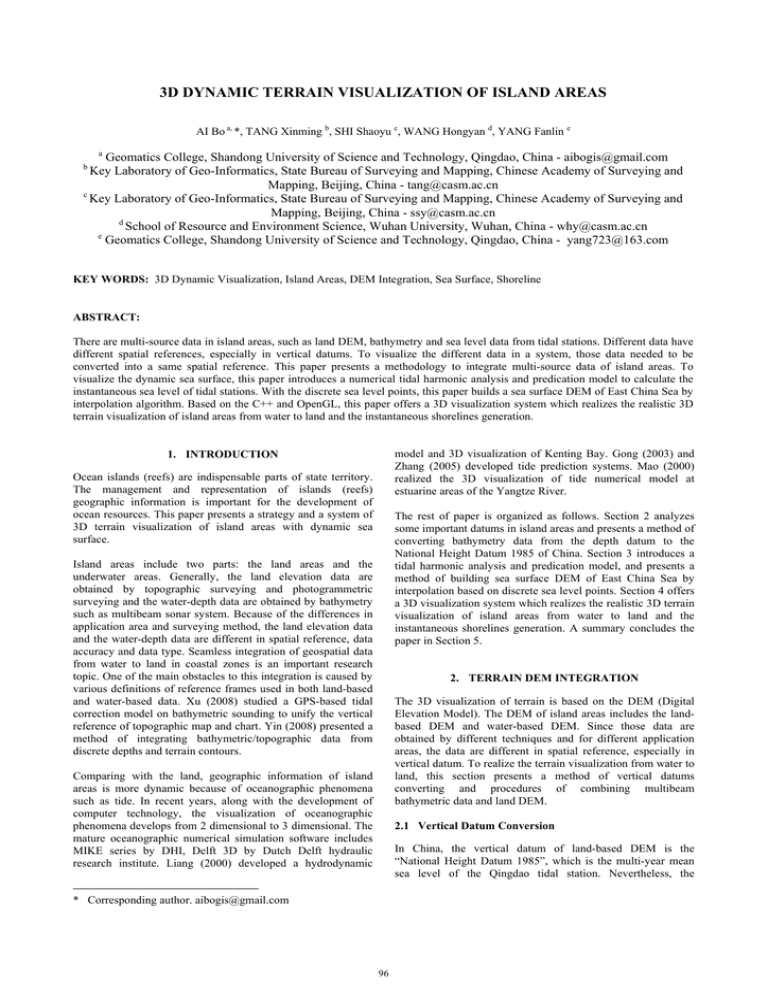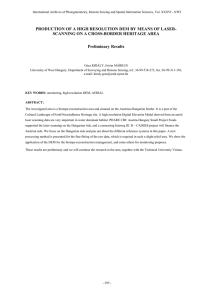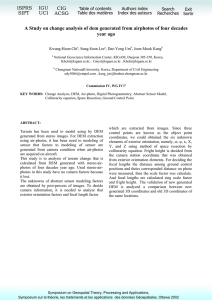3D DYNAMIC TERRAIN VISUALIZATION OF ISLAND AREAS
advertisement

3D DYNAMIC TERRAIN VISUALIZATION OF ISLAND AREAS AI Bo a, *, TANG Xinming b, SHI Shaoyu c, WANG Hongyan d, YANG Fanlin e a Geomatics College, Shandong University of Science and Technology, Qingdao, China - aibogis@gmail.com Key Laboratory of Geo-Informatics, State Bureau of Surveying and Mapping, Chinese Academy of Surveying and Mapping, Beijing, China - tang@casm.ac.cn c Key Laboratory of Geo-Informatics, State Bureau of Surveying and Mapping, Chinese Academy of Surveying and Mapping, Beijing, China - ssy@casm.ac.cn d School of Resource and Environment Science, Wuhan University, Wuhan, China - why@casm.ac.cn e Geomatics College, Shandong University of Science and Technology, Qingdao, China - yang723@163.com b KEY WORDS: 3D Dynamic Visualization, Island Areas, DEM Integration, Sea Surface, Shoreline ABSTRACT: There are multi-source data in island areas, such as land DEM, bathymetry and sea level data from tidal stations. Different data have different spatial references, especially in vertical datums. To visualize the different data in a system, those data needed to be converted into a same spatial reference. This paper presents a methodology to integrate multi-source data of island areas. To visualize the dynamic sea surface, this paper introduces a numerical tidal harmonic analysis and predication model to calculate the instantaneous sea level of tidal stations. With the discrete sea level points, this paper builds a sea surface DEM of East China Sea by interpolation algorithm. Based on the C++ and OpenGL, this paper offers a 3D visualization system which realizes the realistic 3D terrain visualization of island areas from water to land and the instantaneous shorelines generation. 1. INTRODUCTION model and 3D visualization of Kenting Bay. Gong (2003) and Zhang (2005) developed tide prediction systems. Mao (2000) realized the 3D visualization of tide numerical model at estuarine areas of the Yangtze River. Ocean islands (reefs) are indispensable parts of state territory. The management and representation of islands (reefs) geographic information is important for the development of ocean resources. This paper presents a strategy and a system of 3D terrain visualization of island areas with dynamic sea surface. The rest of paper is organized as follows. Section 2 analyzes some important datums in island areas and presents a method of converting bathymetry data from the depth datum to the National Height Datum 1985 of China. Section 3 introduces a tidal harmonic analysis and predication model, and presents a method of building sea surface DEM of East China Sea by interpolation based on discrete sea level points. Section 4 offers a 3D visualization system which realizes the realistic 3D terrain visualization of island areas from water to land and the instantaneous shorelines generation. A summary concludes the paper in Section 5. Island areas include two parts: the land areas and the underwater areas. Generally, the land elevation data are obtained by topographic surveying and photogrammetric surveying and the water-depth data are obtained by bathymetry such as multibeam sonar system. Because of the differences in application area and surveying method, the land elevation data and the water-depth data are different in spatial reference, data accuracy and data type. Seamless integration of geospatial data from water to land in coastal zones is an important research topic. One of the main obstacles to this integration is caused by various definitions of reference frames used in both land-based and water-based data. Xu (2008) studied a GPS-based tidal correction model on bathymetric sounding to unify the vertical reference of topographic map and chart. Yin (2008) presented a method of integrating bathymetric/topographic data from discrete depths and terrain contours. 2. TERRAIN DEM INTEGRATION The 3D visualization of terrain is based on the DEM (Digital Elevation Model). The DEM of island areas includes the landbased DEM and water-based DEM. Since those data are obtained by different techniques and for different application areas, the data are different in spatial reference, especially in vertical datum. To realize the terrain visualization from water to land, this section presents a method of vertical datums converting and procedures of combining multibeam bathymetric data and land DEM. Comparing with the land, geographic information of island areas is more dynamic because of oceanographic phenomena such as tide. In recent years, along with the development of computer technology, the visualization of oceanographic phenomena develops from 2 dimensional to 3 dimensional. The mature oceanographic numerical simulation software includes MIKE series by DHI, Delft 3D by Dutch Delft hydraulic research institute. Liang (2000) developed a hydrodynamic 2.1 Vertical Datum Conversion In China, the vertical datum of land-based DEM is the “National Height Datum 1985”, which is the multi-year mean sea level of the Qingdao tidal station. Nevertheless, the * Corresponding author. aibogis@gmail.com 96 multibeam bathymetric data is often based on the local depth datum, which is the local lowest normal low sea level, see the Figure 1. Multibeam Bathymetric Data Depth Contours of Charts Vertical Datum Conversion Horizontal Datum Conversion Grid Land DEM Interpolation Figure 1. Some important vertical datums In the Figure 1, ΔH is the distance between the levelling origin and the zero point of the tidal station. MSL is the distance between the mean sea level and the zero point of the tidal station. h0 is the distance between the local mean sea level and the sea floor; h is the distance between the depth datum and the sea floor, namely the water depth result of multibeam bathymetry. L is the numerical value of the depth datum based on the mean sea level. Δ1 is the distance between the local mean sea level and the National Height Datum 1985, and Δ2 is the distance between the depth datum and the National Height Datum 1985. H is the water depth value based on the National Height Datum 1985, which can combine with land DEM as the elevation of sea floor terrain. Grid Water-based DEM Horizontal Datum Conversion Resolution Conversion Resolution Conversion DEM Integration Grid DEM of Island Areas From the Figure 1, the following equation can be obtained: h0 = h + L Figure 2. Flow of grid DEM integration from water to land H = h + Δ2 Δ 2 = L − Δ1 After the vertical datum conversion and the horizontal conversion, the multibeam bathymetric data or the depth contours can be converted to grid DEM by interpolation. Then the water-based DEM and the land-based DEM can be resampled to a same resolution, and then they can be integrated into a grid DEM of the whole island areas. The Figure 3 gives an example of grid DEM integration of seafloor DEM and land DEM. The local mean sea level can be the arithmetic average of the observed values of the tidal station. By the ordinary levelling surveying, ΔH can be calculated and the elevation value of the zero point of the tidal station can be obtained. And then we can get the elevation value of the mean sea level based on the National Height Datum 1985. In other words, Δ1, the distance between the mean sea level and the National Height Datum 1985 can be obtained. Seafloor DEM Land DEM So, the conversion method from the depth datum to the National Height Datum 1985 can be deduced as following equation: H = h + L − Δ1 2.2 Data Processing With the same spatial reference and resolution, grid land-based DEM and water-based DEM can be integrated. This paper presents procedures to combine multibeam bathymetric data and land DEM, see the following diagram. Figure 3. An example of grid DEM integration from water to land 97 3. DYNAMIC SEA SURFACE Nevertheless, many times, islands are far from the mainland. How to obtain the sea level of the far island areas? Dynamic sea surface is an important part of island areas. This section introduces a numerical tidal harmonic analysis and predication model to calculate the instantaneous sea level at a given time. By interpolation based on the instantaneous sea level points of tide station, this section presents a method to build a sea surface DEM. Based on the observation sea levels or the predicated sea levels of discrete tide stations, this paper builds the continuous sea surface DEM of East China Sea by the inverse distance weighted (IDW) interpolation. The Figure 5 gives the sea surface DEM of the East China Sea at 00:00 and 07:00 someday, and the positions of the tide stations are marked by the green points and labelled with the city name and the predicted instantaneous sea level. With the sea surface DEM, the instantaneous sea level of the far island areas can be obtained by spatial overlapping. 3.1 Tidal Harmonic Analysis and Predication Based on the long-term tide observation data, the tidal harmonic analysis model calculates the tidal harmonic constants, and then estimates the tide height at a given zonetime t, see the following equation: m ξ (t ) = A0 + ∑ f i H j cos[ σ j t + (V0 + u ) j − g j ] j =1 where, A0 is the distance between the mean sea level and the depth datum of chart, which makes the factual water depth at somewhere can be calculated by adding the predicted tide height to the charted water depth. f is the node factor; σ is the angular velocity of tidal constituents; (V0 + u ) is the initial phase angle of equilibrium tide at 0 GMT. H and g are the harmonic constants of tidal constituents: H is the mean amplitude and g is the epoch of constituents. For a given time, the tide height ξ based on the depth datum can be calculated by the numerical model. To visualize the dynamic sea level with terrain of island areas, the sea level must be converted from the depth datum to the National Height Datum 1985. From the Figure 1 in the Section 2.1, the following equation can be obtained: L = Δ1 + Δ 2 SeaLevel = ξ − Δ 2 Sea surface DEM at 00:00 someday So, the sea level based on the National Height Datum 1985 is: SeaLevel = ξ − L + Δ 1 The Figure 4 gives a 2D predicted sea level hydrograph of a single tidal station, and the hydrograph represents the dynamic variation of the sea level in a day. Figure 4. A predicted sea level hydrograph of a single tidal station in a day 3.2 SEA SURFACE DEM OF EAST CHINA SEA The sea level of main harbours and tidal stations can be calculated by the numerical tidal harmonic analysis model. Sea surface DEM at 07:00 someday Figure 5. Sea surface DEM of the East China Sea 98 4. 3D DYNAMIC VISUALIZATION SYSTEM OF ISLAND AREAS 1) For the land part, match the high-resolution orthophoto with DEM, and then render the land surface by the corresponding orthophoto as texture. For years, viewing geospatial data in 3D has been the effective way to understand the complex datasets. This study develops a 3d dynamic visualization system of island areas based on the OpenGL. 2) For the seafloor part, render each underwater 3D point by RGB colors according to its elevation. The lower elevation is in the deeper blue color, the higher one is in the lighter blue color. 4.1 System Design The Figure 7 is a snapshot of the system displaying 3D terrain of island areas. This system is developed based on C++ and OpenGL (Open Graphics Library) which is a standard specification defining a cross-language and cross-platform API for writing applications that produce 3D computer graphics (and 2D computer graphics as well). The UML class diagram is an efficient tool for the software designing and developing, which can be directly mapped with object oriented languages. The Figure 6 gives a simple UML class diagram of the 3D visualization system. Figure 7. A snapshot of 3D visualization of island areas 4.3 Instantaneous 3D Shorelines Generation This paper converts the terrain DEM and sea surface DEM into a same vertical datum, and so the system can generate instantaneous shorelines by intersecting terrain DEM of islands with sea surface. The Figure 8 gives two instantaneous shorelines of an island at different sea levels. Figure 6. A simple UML class diagram of the 3D visualization system In the class diagram, the CScene class is the foundation class of the system, and it provides the management and the visualization of 3D data of island areas. Associated with the CScene class, the CCamera class and the CFrustum class define the visual angle and extent. There are four types of data in the system: building model, terrain DEM, sea surface DEM and feature (vector data). Some 3D building model files, such as .3ds file, can be read and visualized by the CBuilding class. The CTerrain class has two derived classes: the CGridDEM class and the CTIN class, corresponding to the two types of DEM respectively. The CSeaSurfaceDEM class provides the functions about the dynamic sea surface visualization. For all vector data, the CFeatureLayer class is used. Derived from the CFeatureLayer class, the CShorelinesLayer class is designed for the special characteristics of shorelines. To realize the 3D realistic visualization, the CTexture class is designed to manage realistic textures for terrains and buildings. Sea level = -0.5 4.2 3D Terrain Visualization from Water to Land Based on the methods in precious sections, the bathymetric data and land elevation data can be converted into a same datum and then be combined into a DEM. With the integrated DEM, the system realizes the 3D terrain visualization from water to land. The system makes the 3D terrain more realistic by the following two steps: Sea level = 1.1 99 System of the East China Sea with GIS. Marine Geodesy, 22, pp. 115-128. Figure 8. Two instantaneous shorelines of an island at different sea levels, and the two pairs of rectangle highlight the difference comparison between the two shorelines Moore, L.J., 2000. Shoreline mapping techniques. Journal of Coastal Research , 16(1):111-124. 5. CONCLUSION Mao, L., Yan, Y. and Song, Z., 2000. Visualization of calculation of tidal current. Ocean Engineering, 18(4), pp. 8689. This paper presents a methodology to integrate geospatial data in island areas. There are different source data in island areas, such as land DEM, bathymetry and sea level data from tidal stations. Different data have different spatial references, especially in vertical datums. To visualize the different data in a system, those data needed to be converted into the same spatial reference. Based on the analysis of some important vertical datums in island areas, this paper presents a method of converting the depth datum of bathymetry data to the National Height Datum 1985 of China. With the same spatial reference and resolution, grid land-based DEM and water-based DEM can be integrated. This paper also presents procedures to convert the multibeam bathymetric data to grid DEM and then combine with the land DEM. Shaw, B., and J.R. Allen, 1995. Analysis of a dynamic shoreline at Sandy Hook, New Jersey, using a Geographic information system. Proceeding of ASPRS/ACSM, pp. 382–391. Smith, G. M., Spencer, T., and Moller, I., 2000. Visualization of coastal dynamics: Scolt Head Island, North Norfolk, England Estuarine, Coastal and Shelf Science, 50, pp. 137–142. Xu, Y., Huang, C., Shen J., 2008. Effect and correction of tide on multibeam bathymetric sounding. Hydrographic Surveying And Charting, 28(2), pp. 29-32. Yi, L., 2004. Advance of the Researches on the Variations of Mean-Sea-Level (MSL) in the Coastal Waters of China. Periodical of Ocean University Of China, 34(5), pp. 34-39. To visualize the dynamic sea surface of island areas, this paper introduces a numerical tidal harmonic analysis and predication model to calculate the sea level at a given time. This paper also presents a method to build a sea surface DEM by the interpolation based on the sea levels of some important tide station at a same time. Yin, X., Hu, J., Zhang, L., Wu, L. and Chen, Y., 2008. Seamless 3D combination for bathymetric/topographic data. Journal of Dal ian Maritime University, 33(2), pp. 19-23 Zhang, X., Liu, J., Hao, P. and Xiu, Y., 2005. The development and application for the electronic tide gauge. Marine forecasts, 22(2), pp. 72-76. This study develops a 3D terrain visualization system of island areas. Based on the matching grid DEM and high-resolution orthophoto, the system provides realistic 3D visualization from water to land. Besides visualization functions, this system also realizes the function of instantaneous 3D shorelines generation. ACKNOWLEDGEMENTS This research is supported by the National High Technology Research and Development Program of China (863 Program) (Grant No. 2007AA12Z346—5(2)), the National Natural Science Foundation of China (Grant No. 40876051), the Scientific Research Foundation of CASM (Grant No. 77735), the Key Laboratory of Geo-informatics of State Bureau of Surveying and Mapping (Grant No. 200809) and the Research Project of " SUST Spring Bud " (Grant No. 2008AZZ025). REFERENCES Ai, B., Ai, T. and Tang, X., 2008. Progressive Transmission of Vector Map On the Web, Proceedings, The XXI Congress of the International Society for Photogrammetry and Remote Sensing, Beijing, Volume XXXVII, Part B2-1, Commission II, pp. 411417. Gong, Z., Zhang, D. and Zhang, L., 2003. A processing system for hydrological field data in estuaries and coasts. Journal of Hydraulic Engineering, 2003(1), pp. 83-87. Liang, S. J., 2000. A 3D Kenting Bay Hydrodynamic Model System: Integrating GIS, Modeling and Visualization. Proceedings, 4th International Conference on Hydro-Science and –Engineering, Seoul, Korea. Lin, H., Lu G., Song, Z. and Gong, J., 1999. Modeling the Tide 100





